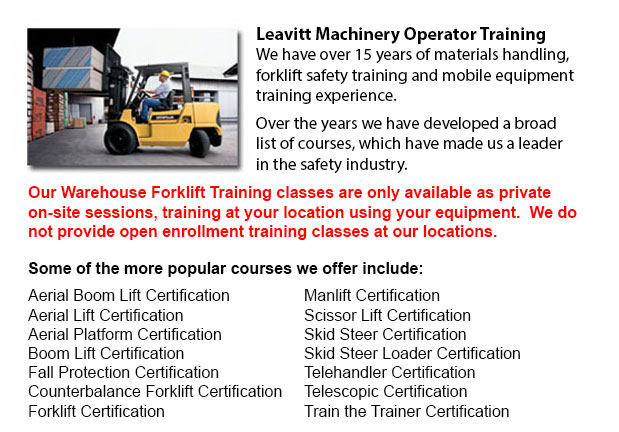
Warehouse Forklift Training Programs Richmond Hill - Warehouses could be commercial, retail or industrial facilities. Their function could vary from product distribution to retailing bulk products. Regardless of the type of warehouse, employees in warehouse settings must be well trained in safety measures related to material handling and storage, conveyor systems, loading docks, and pallet jacks and forklifts. Good housekeeping is important to a safe and orderly warehouse setting.
Truck and loading dock systems are often located at a height from the ground. Products enter and exit warehouses through these systems where staff load and unload materials from elevated docks and ramps. Particular attention must be paid to safety practice in this stage. In order to avoid falls, install yellow striping along the edge of ramps and docks. Pay attention to the area all-around delivery trucks which are parked at the loading dock, especially the part between dock and the truck. Be sure that truck wheels are chocked when unloading.
To be able to distribute products inside the facility, some warehouses use a conveyor system. These systems are designed with moving belts and wheels which can pose a pinch point hazard. Keep parts of the body and hair well away from conveyors to prevent injury. Elevated conveyors pose a hazard to employees underneath if safety nets are absent. Personnel should know how to stop conveyors in case of emergency. Be aware of the location of off switches and emergency stop buttons. When servicing conveyors, lock out/tag out measures are mandatory.
In order to make it easier to move supplies, pallet jacks and forklifts are most usually utilized. The operator of the lift truck would need training and certification. Operators of pallet jacks do not need certification, but should be trained on the equipment. Training programs instruct operators in the right methods for lifting materials and transporting them to their assigned location. Neither forklifts nor pallet jacks should ever be utilized to lift or transport staff.
Rack system and storage shelving help to create an orderly and efficient work area if they are braced, sturdy, and allow sufficient room for individuals and machinery to pass. Careful and slow placement of good is needed to avoid accidents caused by products falling off the facing aisle. Aisles should be kept clear by storing products flat and within the shelving units. Pallets are made use of for stacking products. They should be in good condition, and palleted products should be shrink-wrapped or baled, whenever possible.
Personal protective equipment (or likewise known as PPE) should be worn, as appropriate, to protect employees' heads, limbs, feet and hands. Hard hats or bump caps, gloves and steel-toed shoes are common PPE.
Slippery floors which are pocked with pits and dents can present significant dangers, making good housekeeping extremely essential. Warehouse floors and docks must be clear of oil, dirt and debris. The space must be kept clear of boxes, baling materials and garbage.
-
Scissor Lift Certification Richmond Hill
Scissor Lift Certification Richmond Hill - Scissor lift platforms are utilized at work sites in order to allow tradespeople - like for example welders, masons and iron workers - to reach their work. Operating a scissor lift platform is usually second... More -
Narrow Aisle Forklift / Order Picker Training / Electric Pallet Jack / Electric Pallet Truck Training in Richmond Hill
A pallet jack is a model of equipment specialized in the transporting of pallets of many dimensions and weights. They might be utilized as an appendage for lift trucks, cranes and other types of heavy machinery or be used on their own. Pallet jacks a... More -
Heavy Equipment Operator Certification Richmond Hill
Heavy Equipment Operator Certification Richmond Hill - The heavy equipment operator is a person who manipulates the controls and drives various kinds of big machinery. Heavy machinery is most frequently used on construction sites in order to deliver... More -
Loader Training Richmond Hill
Loader Training Richmond Hill - Why You Must Finish A Loader Training Course - Individuals wanting work in businesses that use lift trucks must undergo a Loader Training program prior to becoming a certified operator of a lift truck. There are lots o... More -
Manlift Training Richmond Hill
Manlift Training Richmond Hill - Various manlift training programs consist of the review and content of manlift devices. An important part of the course is the practicum where students show their knowledge and practical ability to safely operate a ma... More -
Fall Protection Training in Richmond Hill
There are many injuries at work associated to falling and a lot of fall-related deaths reported every year. Most of these instances could have been prevented with better training, better measures in place, and by correctly equipping personnel before... More -
Wheel Loader Training Richmond Hill
Wheel Loader Training Richmond Hill - Commonly, the various kinds of heavy equipment training are classed into 2 categories of machinery: those which have rubber tires and tracked vehicles. Tracked vehicles consist of items like cranes, bulldozers an... More -
Forklift Certification Schools Richmond Hill
Forklift Certification Schools Richmond Hill - Forklift Certification is mandatory in North America. Hence, forklift training programs are important both for companies and for people seeking jobs in industries as forklift operators. Forklift training... More

Forklift Training Richmond Hill
TOLL FREE: 1-888-254-6157
Richmond Hill, Ontario
forklifttrainingrichmondhill.com
Email Us
About Us


